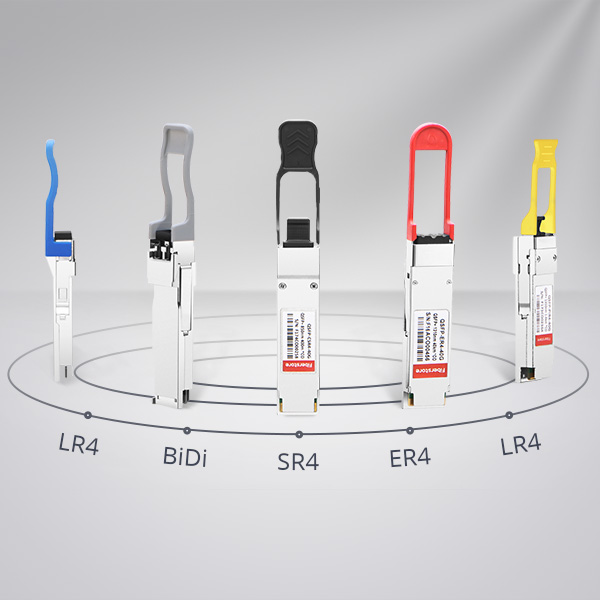Why Third-party 40G QSFP+ Transceiver, Instead of OEM QSFP Module?
petak , 25.08.2017.For the data center or network upgrade, 40G network is a trending choice. Then where do you buy the 40G QSFP transceiver? Will you choose an OEM one or a third-party one? There are some differences between third-party 40G QSFP transceiver and OEM 40G QSFP transceiver, which will be shown below.
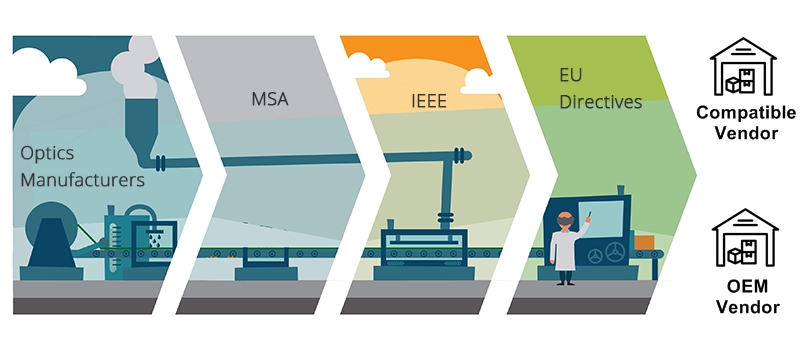
Features of OEM 40G QSFP Transceiver Modules
As we know, the OEM 40G QSFP transceiver from name brand like Cisco, Juniper and Brocade is widely used in data center and enterprise network. They all have some great features. The Cisco 40G QSFP transceiver offers a wide variety of high-density and low-power 40 Gigabit Ethernet connectivity options for data center, high-performance computing networks, enterprise core and distribution layers, and service provider applications. Here are some benefits of Cisco 40 Gbps transceiver:
- Hot-swappable input/output device that plugs into a 40 Gigabit Ethernet Cisco QSFP port
- Flexibility of interface choice (for different reach requirements and fiber types)
- Interoperable with other IEEE-compliant 40GBASE interfaces where applicable
- Certified and tested on Cisco QSFP 40G ports for superior performance, quality, and reliability
- High-speed electrical interface compliant to IEEE 802.3ba
- QSFP Form factor, 2-wire I2C communication interface and other low-speed electrical interface compliant to SFF 8436 and QSFP
The Brocade 40 Gbps transceiver supports highly reliable operations in data center and is optimized for Brocade switching platforms. It undergoes strict qualification and certification testing.
Why Choose 3rd 40G QSFP Optical Transceivers Over OEM?
40G QSFP transceiver from Cisco and Brocade is reliable and with high-quality, but why so many third-party 40 Gbps transceiver occurred on the market? The answer seems simple, the transceiver market need it. With high-speed development of the optical communication industry, the demand for 40G QSFP transceiver is increasing. The third-party 40G QSFP with good compatibility and high stability is the perfect choice for some customers. Here are some amazing advantages of the third-party 40 Gbps transceiver:
- Price advantage
Optics that you buy directly from name brand is expensive because it includes the costs of testing and validation, and the majority of what you pay for goes into their pocket as pure profit. While the third-party providers may not use the same testing procedures as the name brand, but most have nearly 100% success in compatibility. The third-party providers don’t mark up the 40G QSFP as much as the name brand, so they offer better price for the customer.
- Quality and Reliability
The third-party 40Gbps transceiver is reliable as the original one if you buy from a reliable optics provider. Usually, the reliable third-party provider will offer warranty and support after you buy from them, because they are highly focused and specialize in the optical transceiver market.
- More choice for 40G QSFP transceiver
The third-party optical transceiver is compatible for most name brand transceivers, so it will have more choice for your data center and enterprise networks.
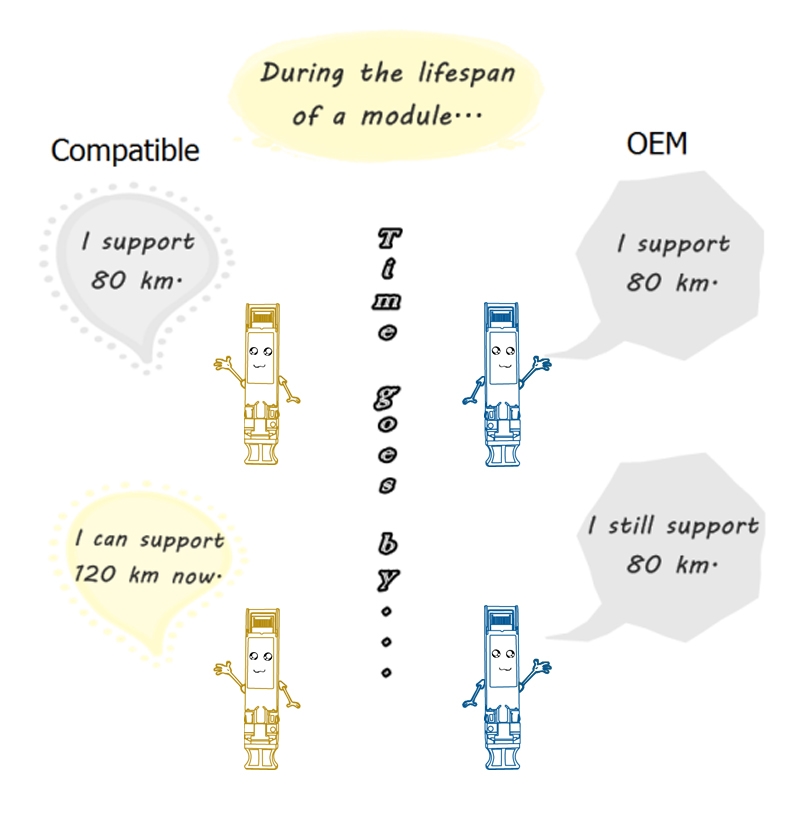
For the 40 Gbps transceiver, FS.COM provides various of compatible brands for you, Cisco, Genetic, Juniper Networks, Arista Networks, Brocode, HPE, Dell, Intel, IBM, etc. All have passed the compatibility testing.
Conclusion
After the comparison, will you choose the third-party 40G QSFP transceiver? Using third-party optics instead of name brand optics is a smart and innovative way to embrace changes in the dynamic networking and date center hardware markets. FS.COM will be you good choice with good compatibility, support offerings and great reputation.
Original Source: Why Third-party 40G QSFP+ Transceiver, Instead of OEM QSFP Module?
Oznake: 40G QSFP+ transceiver, 40G QSFP module, Third-party 40G QSFP Transceiver, OEM 40G QSFP Transceiver
komentiraj (0) * ispiši * #
Introduction to Semiconductor Optical Amplifier (SOA)
petak , 11.08.2017.Optical amplifier, with the introduction in 1990s, conquered the regenerator technology and opened doors to the WDM technology. It is mainly used to amplify an optical signal directly, without the need to first convert it to an electrical signal. There are many types of optical amplifiers, namely Raman amplifiers, erbium doped-fiber amplifiers (EDFAs), and semiconductor optical amplifier (SOA). This article will make a clearer introduction to SOA amplifier, and analyze its advantages and disadvantages.
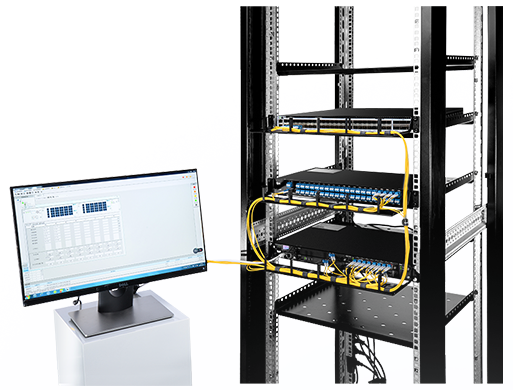
The Basics of Semiconductor Optical Amplifier (SOA)
SOA optical amplifiers use the semiconductor as the gain medium, which are designed to be used in general applications to increase optical launch power to compensate for loss of other optical devices. Semiconductor optical amplifiers are often adopted in telecommunication systems in the form of fiber-pigtailed components, operating at signal wavelengths between 0.85 µm and 1.6 µm and generating gains of up to 30 dB. Semiconductor optical amplifier, available in 1310nm, 1400nm, 1500nm, 1600nm wavelength, can be used with singlemode or polarization maintaining fiber input/output.
Key Points of SOA Amplifier
- 1310 nm, 1400 nm, 1550 nm and 1610 nm wavelength selectable
- High fiber-to-fiber gain of 20 dB
- Up to 16 dBm output
- 1 MHz with 10 ns pulse width (optional)
- PM Panda fiber input/output (optional)
- Similar to lasers, but with non-reflecting ends and broad wavelength emission
- Incoming optical signal stimulates emission of light at its own wavelength
- Process continues through cavity to amplify signal
Working principle of SOA amplifier
The basic working principle of a SOA is the same as a semiconductor laser but without feedback. SOAs amplify incident light through simulated emission. When the light traveling through the active region, it causes these electrons to lose energy in the form of photons and get back to the ground state. Those stimulated photons have the same wavelength as the optical signal, thus amplifying the optical signal.
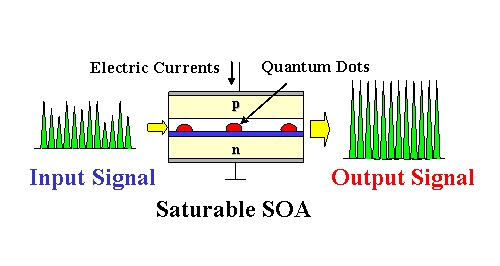
SOA Over EFDA in DWDM Networks
As the solution below, 120km Metro Networks by Using an SOA amplifier. You may wonder why not use EDFA in the above networks.

Theoretically, SOA optical amplifiers are not comparable with EDFA in the terms of performance. The noise figure of SOA optical amplifier is typically higher, the gain bandwidth can be similar, SOAs exhibit much stronger nonlinear distortions in the form of self-phase modulation and four-wave mixing. Yet, the semiconductor optical amplifier is of small size and electrical pumped, which is often less expensive than EDFA. Additionally, SOA can be run with a low power laser.
How to Choose SOA Optical Amplifier?
When selecting SOA amplifier, you have to check the every detailed parameter in the product data sheet. But, seriously, do you understand it? No, please read the following part.
The key parameters used to characterize a SOA amplifier are gain, gain bandwidth, saturation output power and noise.
Gain is the factor by which the input signal is amplified and is measured as the ratio of output power to input power (in dB). A higher gain results in higher output optical signal.
Gain bandwidth defines the range of bandwidth where the amplification functions. A wide gain bandwidth is desirable to amplify a wide range of signal wavelengths.
Saturation output power is the maximum output power attainable after amplification beyond which no amplification is reached. It is important that the SOA has a high power saturation level to remain in the linear working region and to have higher dynamic range.
Noise defines the undesired signal within the signal bandwidth which arises due to physical processing in the amplifier. A parameter called noise figure is used to measure the impact of noise which is typically around 5dB.
Conclusion
SOA amplifier is the economic, high-performance solution for long-hual WDM networks. SOA amplifier, due to its features, can be used in Booster and in-line amplification, optical network, general purpose test and measurement and fiber sensing. However, it also has its limit. In semiconductor optical amplifiers, electron-hole recombination occurs which will affect the performance of the whole line. FS offers EDFA, SOA, Raman optical amplifiers of excellent quality and price. For more detailed information, please feel free to contact us.
Original Source: Semiconductor Optical Amplifier
komentiraj (0) * ispiši * #
